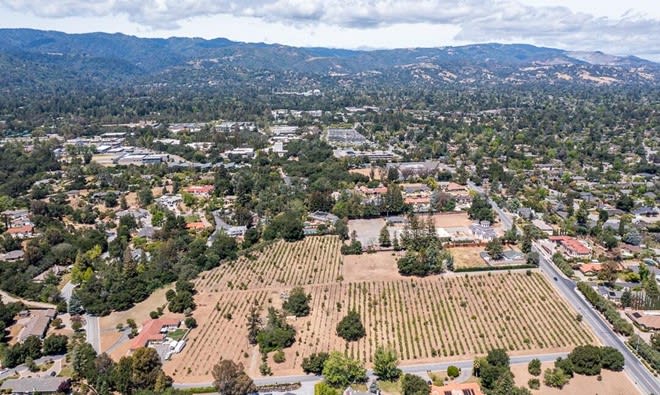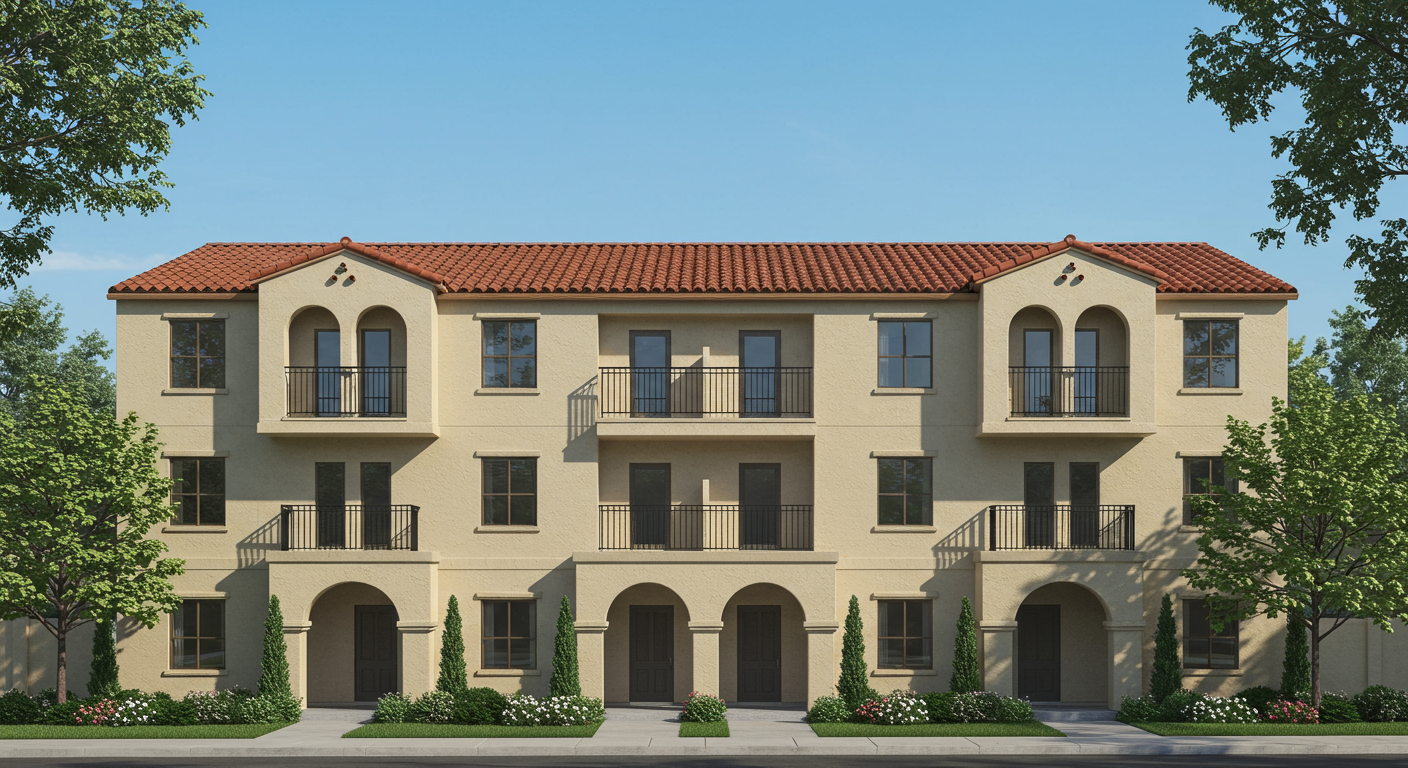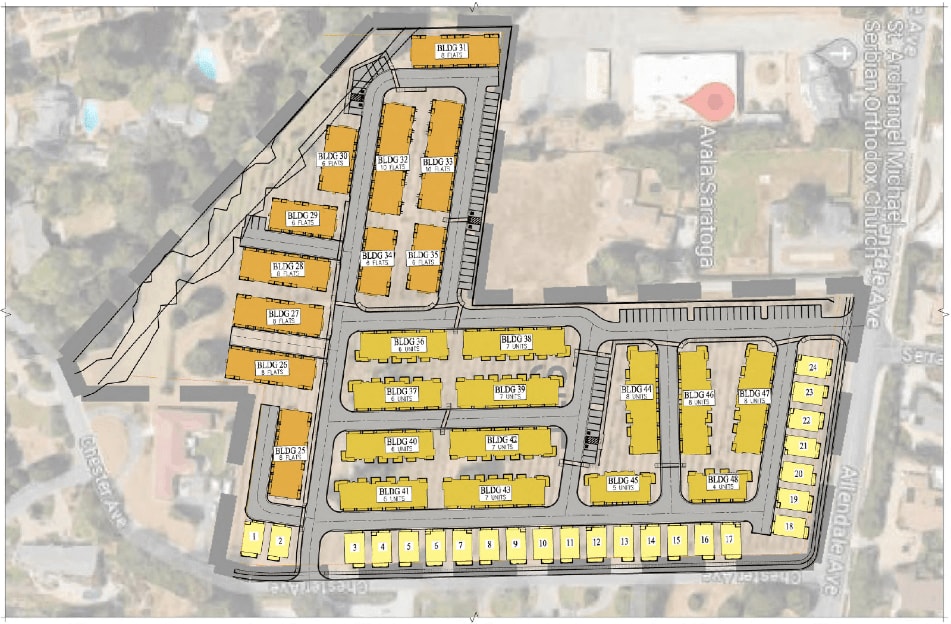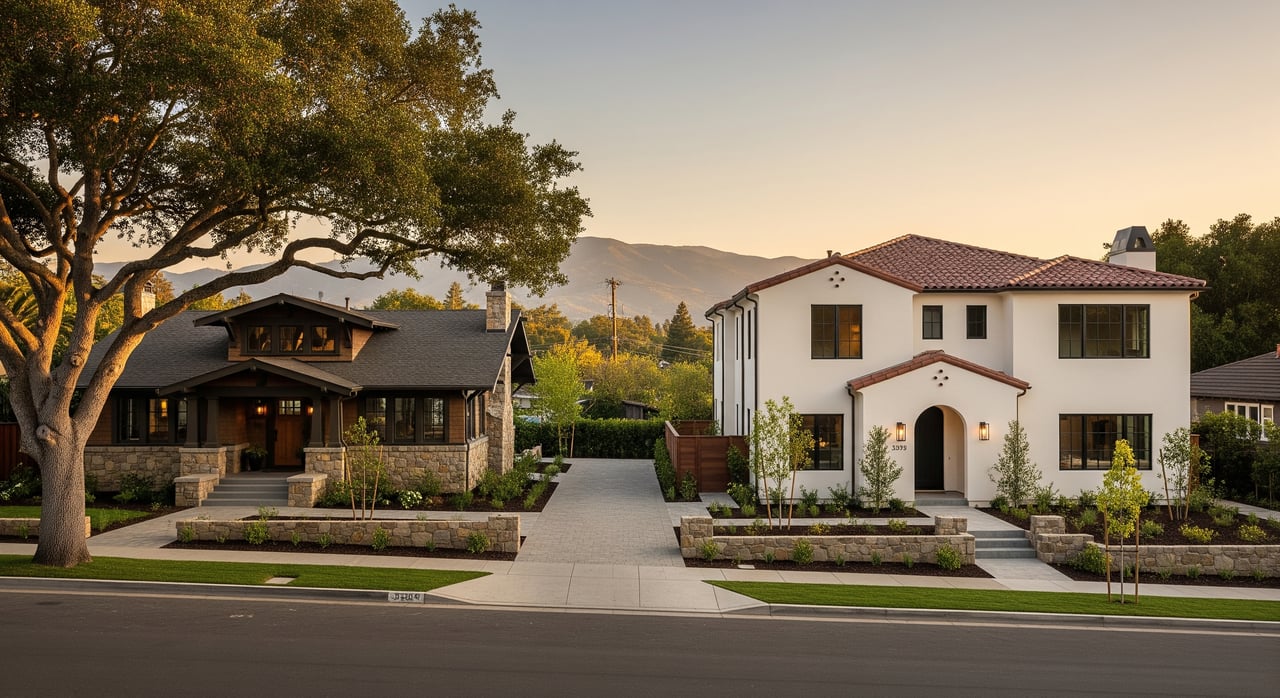A sizable housing development is presently undergoing scrutiny in one of Saratoga’s most coveted neighborhoods, and it's significant in scale. We've opted to shine a spotlight on this particular project because it's situated in the neighborhood where we have our roots, and the legislative maneuvers being employed to bypass local zoning regulations are relatively unfamiliar to many today. Nevertheless, this strategy is likely to become more commonplace as the state grapples with meeting its targets for new, accessible housing.
The site is an 11.57-acre vineyard located at the intersection of Allendale Drive and Chester Avenue.
-
238 units, with three different residential unit types
-
24 three-story detached single-family homes with each of the units containing an accessory dwelling unit on the first floor
-
13 multi-family buildings containing 85 three-story townhomes; 15 of the townhomes will contain accessory dwelling units
-
11 three-story multi-family buildings, with separate dwelling units on the second and third floors, with parking on the first floor; six of the buildings will include a junior accessory dwelling unit
-
445 on-site parking spaces, including 366 spaces in enclosed
The legislation being utilized is known as the Builders Remedy. Leveraging the city of Saratoga's non-compliance with the Housing Element Law, developers can propose a project of this magnitude in a predominantly single-family home neighborhood where the average lot size is approximately one acre.
In California this legal mechanism, Builder’s Remedy, is rooted in the Housing Accountability Act (1990), particularly in Government Code section 65589.5(d)(5). It was established to encourage the development and streamline the process of affordable housing in jurisdictions that have not complied with state Housing Element Law. This law mandates that cities and counties have a state-approved plan to accommodate future housing needs. When local governments fail to maintain such plans, the Builders Remedy allows developers to bypass local zoning regulations regarding aspects like height and density to construct housing projects. With the contingency that these new projects include 20% in affordable units.
The recent Housing Crisis Act of 2019, also known as Senate Bill 330, enhanced the frequency and applicability of the Builders Remedy in several California cities. This Act was part of a broader legislative effort to address the state's severe housing shortage and affordability crisis. It aimed to accelerate housing construction by streamlining the approval process, reducing the ability of local governments to downzone, and limiting their capacity to impose moratoriums on housing construction. As a result, the Builders Remedy has gained more prominence as a tool for developers to propose and potentially execute housing projects in areas that are non-compliant with state housing mandates, thereby increasing the number of housing projects initiated under this provision.
How does a city avoid being susceptible to Builder’s Remedy?
California requires all local governments to plan for housing needs through a component of their General Plan known as the "Housing Element." Since 1969, this mandate ensures that cities and counties develop strategies to meet the housing demands of their communities, encompassing a range of elements like land use, transportation, and housing itself. The process involves updating the Housing Element every five or eight years to reflect changing needs and conditions, and it must comply with state laws to ensure that local jurisdictions provide opportunities for housing development without undue constraints.
Compliance with the Housing Element law is critical as it affects eligibility for various state funding programs related to transportation, infrastructure, and housing. Programs like the Community Development Block Grant Program and the Affordable Housing and Sustainable Communities Program require or give preference to jurisdictions with compliant Housing Elements, enhancing their chances in competitive application processes.
On March 14th the city of Saratoga posted the following update…
“On February 28, 2024, HCD submitted preliminary comments on the fourth draft of the Housing Element. In response to these comments, the City prepared a fifth draft Housing Element. The Public Review period for the fifth draft Housing Element begins on March 15, 2024, and ends on March 22, 2024, at 5:00 p.m. The City Council will consider updates to the fifth draft Housing Element in addition to the Planning Commission’s recommendation on the completed Housing Element, Zoning Amendments, the Environmental Impact Report, and the 2040 General Plan Update at a Public Hearing scheduled for March 20, 2024.”
Are there any sort of checks and balances?
While the Builders Remedy presents a significant opportunity for addressing housing shortages, it is not without limitations and challenges. First, the locality in question must be out of compliance with state housing element law, which is determined by the California Department of Housing and Community Development (HCD). The degree of non-compliance can vary among jurisdictions, affecting their susceptibility to Builders Remedy projects. Projects still need to comply with state and federal laws, building codes, health and safety guidelines, and undergo environmental review processes. The provision is seen as a last resort to compel cities to adopt compliant housing elements and plan for sustainable and resilient growth, rather than relinquishing control over local development decisions.
Summary
Over the past three decades, Silicon Valley has undergone significant transformation, transitioning from an agricultural-based economy to a globally renowned technology hub. This shift has had profound effects, with continued population growth and the perpetual challenge of housing availability. While many individuals generally endorse legislative initiatives aimed at promoting affordable housing, today's blog aims to shed light on how developers are capitalizing on municipalities' difficulties in meeting state quotas. Once a city is deemed non-compliant, there are limited measures it can take to constrain these projects. Consequently, such developments may precipitate drastic changes in certain neighborhoods.







